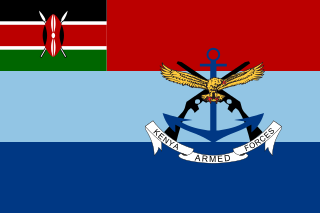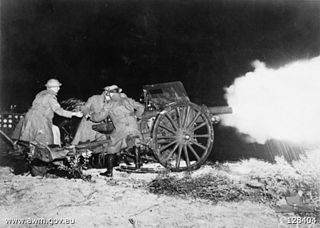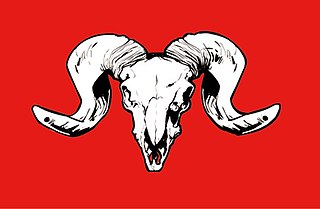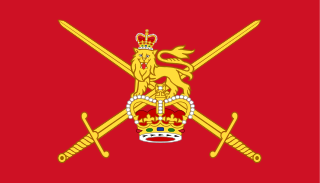Related Research Articles

The Kenya Defence Forces (KDF) are the armed forces of the Republic of Kenya. They are made up of the Kenya Army, Kenya Navy, and Kenya Air Force. The current KDF was established, and its composition stipulated, in Article 241 of the 2010 Constitution of Kenya; it is governed by the KDF Act of 2012. Its main mission is the defence and protection of the sovereignty and territorial integrity of Kenya, recruitment to the KDF is done on yearly basis. The President of Kenya is the commander-in-chief of the KDF, and the Chief of Defence Forces is the highest-ranking military officer, and the principal military adviser to the President of Kenya.

The Royal Regiment of Artillery, commonly referred to as the Royal Artillery (RA) and colloquially known as "The Gunners", is one of two regiments that make up the artillery arm of the British Army. The Royal Regiment of Artillery comprises thirteen Regular Army regiments, the King's Troop Royal Horse Artillery and five Army Reserve regiments.

The Royal Regiment of Australian Artillery, normally referred to as the Royal Australian Artillery (RAA), is a Regiment of the Australian Army descended from the original colonial artillery units prior to Australia's federation. Australia's first guns were landed from HMS Sirius and a small earthen redoubt built, near the present-day Macquarie Place, to command the approaches to Sydney Cove. The deployment of these guns represents the origins of artillery in Australia. These and subsequent defences, as well as field guns, were operated by marines and the soldiers of infantry regiments stationed in Australia. Unlike their British and Canadian equivalents, there are no regiments of horse artillery in the order of battle of the Royal Australian Artillery. The First World War saw the raising of 60 field, 20 howitzer, and two siege batteries along with the heavy and medium trench mortar batteries. Until 19 September 1962 the Australian Artillery was referred to as the 'Royal Australian Artillery', however, on this date Queen Elizabeth II granted the RAA the title of 'The Royal Regiment of Australian Artillery'. The Regiment today consists of Regular and Reserve units.

The 24th Infantry Brigade was an infantry brigade of the British Army from the First World War. It was reraised during the Second World War, as the 24th Infantry Brigade (Guards). During various designations, the brigade was active throughout the Cold War and existed until 1999, when it was merged with the 5 Airborne Brigade to become 16 Air Assault Brigade.

The 1st Regiment, Royal Australian Artillery is a close support regiment attached to the 7th Brigade at Enoggera Barracks in Queensland. The unit was formed in 1914 under the name 1st Australian Field Artillery Brigade, part of 1st Division Artillery during World War I and later served in World War II and the Vietnam War. It is currently re-equipping with M777A2 lightweight towed howitzers.

Gilgil, Kenya, is a town in Nakuru County, Kenya. The town is located between Naivasha and Nakuru and along the Nairobi - Nakuru highway. It is to the west of the Gilgil River, which flows south to feed Lake Naivasha.

The Myanmar Army is the largest branch of the Armed Forces (Tatmadaw) of Myanmar (Burma) and has the primary responsibility of conducting land-based military operations. The Myanmar Army maintains the second largest active force in Southeast Asia after the People's Army of Vietnam.

The Bulgarian Land Forces are the ground warfare branch of the Bulgarian Armed Forces. The Land Forces were established in 1878, when they were composed of anti-Ottoman militia (opalchentsi) and were the only branch of the Bulgarian military. The Land Forces are administered by the Ministry of Defence, previously known as the Ministry of War during the Kingdom of Bulgaria.
3rd Regiment Royal Horse Artillery is a regiment of the Royal Horse Artillery in the British Army. They are currently based at Albemarle Barracks, Northumberland, England.
The 31st Reserve Field Artillery Regiment was a field artillery unit of the Southern Brigade Irish Reserve Defence Forces tasked with the defence of part of County Tipperary and also with providing support to the 1st FAR, a unit of the Irish Army.
The Balkan Front was a military formation of the Bulgarian People's Army, intended for wartime use under the general direction of the Soviet General Staff. If a war was to have broken out between NATO and the Warsaw Pact, the bulk of the Bulgarian army would have been assigned to it.

The Kenya Army is the land arm of the Kenya Defence Forces.

The 59th Division was an infantry division of the British Army during World War I. It was formed in late 1914/early 1915 as a 2nd Line Territorial Force formation raised as a duplicate of the 46th Division. After training in the United Kingdom and saw service in the Easter Rising in April 1916, the division joined the British Expeditionary Force (BEF) on the Western Front in early 1917. It saw action at Ypres and Cambrai, and was almost destroyed during the German Army's Spring Offensive in March 1918. The reconstituted division took part in the final advances of the war.

The 1st Artillery Brigade was a support formation of the British Army as part of the 3rd Division, and oversaw all close support artillery and deep fires units of the army. Under the Future Soldier programme, the brigade merged with 1st Armoured Infantry Brigade to form 1st Deep Recce Strike Brigade Combat Team.
V Battery Royal Horse Artillery was a battery of the Royal Horse Artillery. Formed in 1804, the battery took part in the Napoleonic Wars – notably the Peninsular War and Battle of Waterloo – before being placed into suspended animation in 1816 as part of the usual post-war reductions of the British Army.
T Battery Royal Artillery is an air defence battery of the Royal Artillery that serves with the British Army's 12 Regiment Royal Artillery. It is stationed at Baker Barracks, Thorney Island, West Sussex.

The structure of the British Army of the United Kingdom (UK) is currently being reorganised to the Future Soldier structure. Due to these reforms taking place gradually, it is likely that some areas will not be fully complete. The British Army is commanded by the Chief of the General Staff (CGS), with Army Headquarters which is located in Andover, Hampshire. Subordinate to that post, there is a Commander Field Army, and a personnel and UK operations command, Home Command.

The Special Operations Regiment is a special forces unit of the Kenyan Army, tasked with airborne operations, commando raids, reconnaissance, counter-insurgency, infiltration and other specialized forms of warfare.
The Kenya Army Armoured Brigade is the formation tasked with conducting operations against enemy armour along with close support to infantry units in military operations.
The mission of the Kenya Army Engineers Brigade is to support the Kenya Army in defence of the country against external aggression and to aid civil authority in humanitarian or civic projects.
References
- ↑ https://web.archive.org/web20130325034352/http://www.armyrecognition.com/kenya-kenyan-army-land-ground-forces-uk/kenya_kenyan_army_land_ground_armed_defense_forces_military_equipment_armored_vehicles_intelligence_.html [ dead link ]
- ↑ "Kenya Field Artillery Training".
- ↑ "Kenya Defence Force Operations; Formations of Kenya Army, Battalions and Brigades – Strategic Intelligence Service".
- ↑ "Kenya Army History".
- ↑ "Kenya Army History".